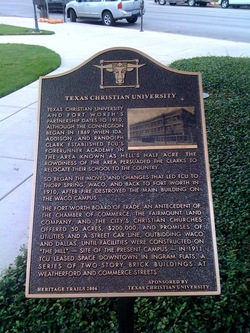
In the first public event, the Fort Worth Chamber and TCU team up again Aug. 30 with the dedication of a Heritage Trails historical marker on the east lawn of the Tarrant County Courthouse at the corner of Commerce and Weatherford Streets, near the site where TCU leased space in 1910.
“Partnership is the perfect word” to describe the relationship of the Chamber of Commerce and TCU, said Mac McLain, chairman of the Fort Worth Chamber Foundation, which funds the Heritage Trails project. “With the Foundation’s focus on education – from early childhood to post-secondary studies – it’s fitting that a Heritage Trails marker chronicles a piece of Fort Worth’s long-time support of higher education.”
“TCU and the City of Fort Worth have enjoyed a mutually-beneficial relationship for the past 100 years,” said TCU Chancellor Victor J. Boschini, Jr. “Through this relationship, TCU has been able to grow and evolve into the world-class, values-centered University it is today. It is hard to imagine TCU without Fort Worth.”
Wording on the marker reads: Texas Christian and Fort Worth Chamber’s partnership dates to 1910, although the connection began in 1869 when Ida, Addison and Randolph Clark established TCU’s forerunner academy in the area known as Hell’s Half Acre. The rowdiness of the area persuaded the Clarks to relocate their school to the country.
So began the moves and changes that led TCU to Thorp Spring, Waco and back to Fort Worth in 1910, after fire destroyed the main building on the Waco campus.
The Fort Worth Board of Trade, an antecedent of the Chamber, the Fairmount Land Company and the city’s Christian Churches offered 50 acres, $200,000 and promises of utilities and a street car line, outbidding Waco and Dallas. Until facilities were constructed on “the Hill” – site of the present campus – in 1911, TCU leased space downtown in Ingram Flats, a series of two-story brick buildings at Weatherford and Commerce streets.
The Heritage Trails project, presently consisting of 22 bronze sidewalk markers along Main Street from Heritage Park to the Water Gardens, tell the story of Fort Worth’s history, people, places and events. A seven-foot-tall, powder-coated steel kiosk at the corner of Main and Second Streets serves as a downtown directory and provides Heritage Trails guide maps.
A joint project of the Fort Worth Chamber Foundation, Fort Worth Convention and Visitors Bureau, and Downtown Fort Worth, Inc., Heritage Trails plaques educate and entertain residents and visitors who are intrigued with Fort Worth’s history and western heritage. The markers bear a signature cubistic longhorn design from 1936 by Evaline Sellors, a sepia-toned screened illustration, and a brief historical narrative. Each four-foot-tall, freestanding marker is sponsored by a local business or organization.
In 2002, Heritage Trails project was launched as the legendary Sleeping Panther sculpture by Deran Wright was installed on the lawn of the Tarrant Co. Administration Building, recalling the 1873 Dallas Herald column citing Fort Worth was such a quiet town that a panther was seen sleeping on Main Street.
